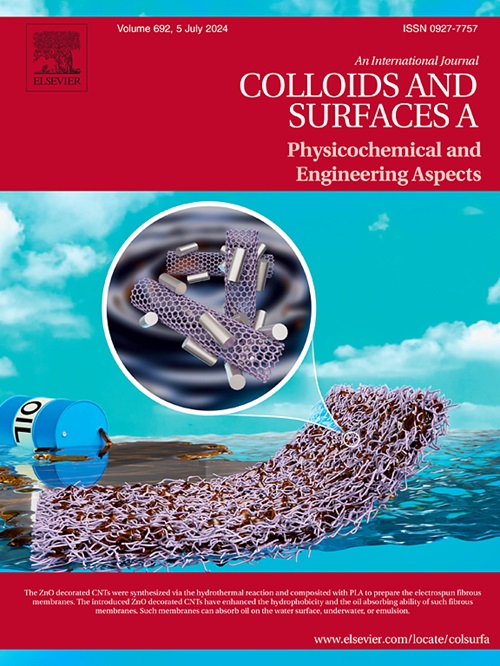直流电场增强采油过程中流体的化学性质和界面行为
IF 4.9
2区 化学
Q2 CHEMISTRY, PHYSICAL
Colloids and Surfaces A: Physicochemical and Engineering Aspects
Pub Date : 2025-06-25
DOI:10.1016/j.colsurfa.2025.137591
引用次数: 0
摘要
碳酸盐岩储层非均质性强,具有采收率低、剩余油分布复杂的特点。电辅助提高采收率技术已经成为一种有前途的、高效的、环保的提高驱油效率的方法。然而,油水岩界面特征仍然是优化电辅助采油性能的关键挑战。在本研究中,通过结合核磁共振流体分布表征的长岩心驱替实验,以及界面张力、润湿性、Zeta电位和分子官能团分析,探讨了电场施加时间影响油-水-岩界面行为的机制。结果表明,在无水采油期后施加电场是最有效的策略,与常规水驱相比,采收率提高了16.90 %。早期施加电场抑制了优先水流通道的形成,有效延缓了水的突破,提高了驱替效率。此外,电场的引入显著降低了注入压力,增强了不同孔隙结构中的石油动员。在水-电耦合驱模式下,峰值压力从11.47 MPa(水驱)降至5.74 MPa,水驱后电场作用将低渗透驱油率提高至40.98 %,将大孔驱油效率从45.30 %提高至49.89 %。提高采收率的主要原因是电场导致界面张力降低和润湿性改变,从而提高驱油效率,扩大波及效率,改善油膜剥离。此外,分子尺度的电化学过程促进了碳氢化合物的重组,表明采出油中的沥青质含量增加到10.77 %,COOH/COO-比降低了30 %,从而稳定了界面活性,增加了岩石表面亲水性,提高了原油的流动性。本研究将宏观驱油实验与微观界面机理分析相结合,阐明电场如何调节多孔介质中油-水-岩的相互作用和影响流体分布。通过研究电场引起的化学反应和组成变化,为碳酸盐岩储层电辅助开发提供了新的认识和理论指导。本文章由计算机程序翻译,如有差异,请以英文原文为准。
Chemical properties and interfacial behavior of fluids during enhanced oil recovery under direct current electric fields
Carbonate reservoirs are characterized by low oil recovery and complex residual oil distribution due to their strong heterogeneity. Electro-assisted enhanced oil recovery technology has emerged as a promising, efficient, and environmentally friendly approach for improving oil displacement efficiency. However, the oil-water-rock interfacial characteristics remain a critical challenge in optimizing the performance of electro-assisted oil recovery. In this study, long-core displacement experiments integrated with nuclear magnetic resonance fluid distribution characterization were conducted, along with interfacial tension, wettability, Zeta potential, and molecular functional group analyses, to investigate the mechanisms by which the timing of electric field application influences oil-water-rock interfacial behavior. The results indicate that applying an electric field after the water-free oil production period is the most effective strategy, leading to a 16.90 % increase in oil recovery compared to conventional water flooding. Early-stage electric field application suppresses the formation of preferential water flow channels, effectively delaying water breakthrough and enhancin displacement efficiency. Furthermore, the introduction of an electric field significantly reduces injection pressure and enhances oil mobilization in various pore structures. Specifically, in the water-electric coupled flooding mode, the peak pressure decreased from 11.47 MPa (water flooding) to 5.74 MPa, while post-water-flood electric field application improved low-permeability oil mobilization to 40.98 % and increased macropore oil displacement efficiency from 45.30 % to 49.89 %. The enhanced oil recovery performance is primarily attributed to electric field-induced interfacial tension reduction and wettability alteration, which enhance displacement efficiency, expand sweep efficiency, and improve oil film detachment. Additionally, molecular-scale electrochemical processes facilitate hydrocarbon restructuring, indicated by an increase in asphaltene content to 10.77 % in the produced oil and a 30 % reduction in the COOH/COO- ratio, which stabilizes interfacial activity, increases rock surface hydrophilicity, and improves crude oil mobility. This study integrates macroscopic oil displacement experiments with microscopic interfacial mechanism analysis to elucidate how electric fields modulate oil-water-rock interactions and influence fluid distribution in porous media. By examining the chemical reactions and compositional changes induced by electric fields, this research provides new insights and theoretical guidance for the electro-assisted development of carbonate reservoirs.
求助全文
通过发布文献求助,成功后即可免费获取论文全文。
去求助
来源期刊
CiteScore
8.70
自引率
9.60%
发文量
2421
审稿时长
56 days
期刊介绍:
Colloids and Surfaces A: Physicochemical and Engineering Aspects is an international journal devoted to the science underlying applications of colloids and interfacial phenomena.
The journal aims at publishing high quality research papers featuring new materials or new insights into the role of colloid and interface science in (for example) food, energy, minerals processing, pharmaceuticals or the environment.

 求助内容:
求助内容: 应助结果提醒方式:
应助结果提醒方式:


